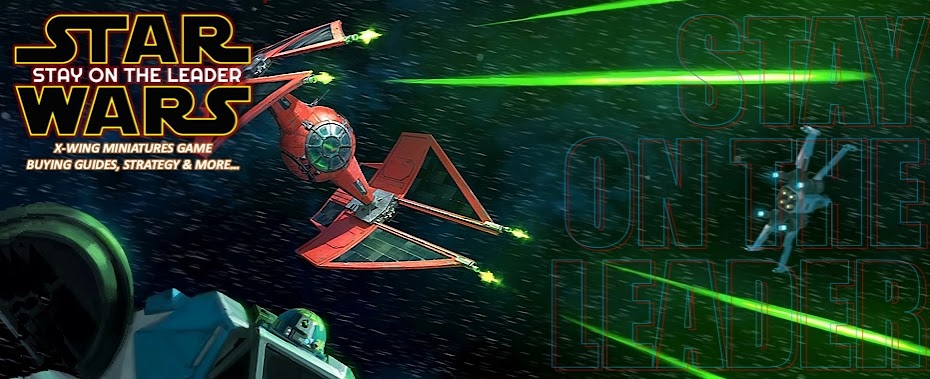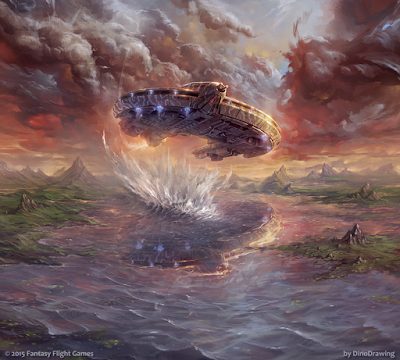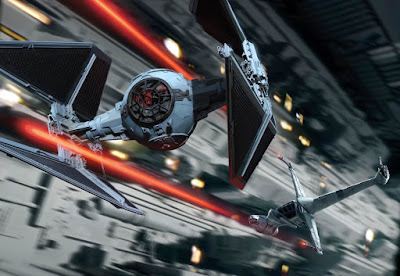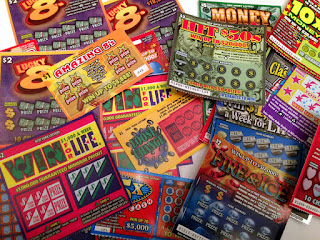Wave 8 hasn't even been available for a full 7 days and already we are starting to get a pretty clear view of the impact it's going to have on the X-Wing metagame, with several Store Championships at the weekend falling to the new "Triple Jumpmaster" squad, which is based heavily on the new ships and upgrade cards of the latest wave of expansions.
I'm not one to be a Chicken Little 'the sky is falling' type when something big hits and shakes things up, but it's clear that the basic Jumpmaster 5000 is bringing something very powerful to the table for a very low points cost. It's not immediately obvious to the casual observer quite why the basic Jumpmaster is so good, though, so in this blog I'm going to put forward my theory for what the Jumpmaster is doing that previous ships have not been able to do.
In short: the Jumpmaster 'solves' Ordnance. Almost ever since the Core set was first released four years ago the history of X-Wing expansions has seen repeated attempts to try and 'buff' what was considered one of the weakest strategies in the game: disposable one-shot Torpedoes and Missiles.
Ordnance like Torpedoes & Missiles have perpetually been the poor relation of simply flying up behind somebody and shooting them with your blasters and laser cannons. That they've spent so long as the whipping boy of X-Wing is testament to just how many little things were going against the humble Proton Torpedo in Core Set - little things that alone weren't a huge problem but added up to a powerful disincentive to run Ordnance.
One by one, the Jumpmaster 5000 ticks off every one of those weaknesses.
1) Torpedoes and Missiles are expensive
With most of the good Torpedoes and Missiles clocking in at 3 to 5 points for a single attack it's not cheap to add them to your ship. This extra cost works against them being used by high cost 'aces' where you've already spent a bunch of points building a formidable high Pilot Skill ship. Take Poe Dameron, for example - he usually clocks in at 35 points for a Poe Dameron with Veteran Instincts, Autothrusters, R5-P9. Once you've already spent that many points on a couple of aces you're finding yourself squeezed for points. If you had to make a decision between flying a strong 3rd ship or a weaker ship and giving Poe Dameron some Proton Torpedoes then the Torpedoes don't offer much extra punch than your ace was already bringing to the table. As well as the cost issue a lot of expensive aces have already boosted their natural firepower, which devalues the Ordnance - by the time you've give Kath Scarlett the elite pilot talent Predator and a Gunner for her crew then she's already dealing a lot of damage with her primary weapons and a Concussion Missile doesn't add a whole lot extra.
The extension of this is that when Torpedoes and Missiles have managed to break into competitive lists they've usually proven most useful on cheap generic pilots, where they add a significant 'alpha strike' onto an otherwise expendable ship that didn't cost you much to put onto the table. Adding one copy of Proton Torpedoes to Poe Dameron doesn't add much, adding five copies of Proton Rockets to five A-Wings is a whole different matter.
This shifts the focus for the Jumpmaster 5000 away from the exciting potential of Dengar and his Punishing One title and onto the humble Contracted Scout. Fortunately, the Contracted Scout has one unique trait - it has an Elite Pilot Talent Slot.
That's about to become extremely important...
2) Cheap generic pilots with low Pilot Skill struggle to Target Lock
Once you've accepted that Torpedoes and Missiles are most attractive for cheap low-PS pilots you immediately run into another problem. Firing most of your Ordnance requires that you have a Target Lock on the ship you want to fire at, but when your low-PS pilots are moving first this is pretty difficult to do. This is for two main reasons:
- Your opponent's ship may be out of range when you take your Target Lock action, then move into range later in the activation phase
- If your opponent's ship is in range when you take your Target Lock action then they might move out of your firing arc later in the activation phase
Basically, trying to Target Lock and fire Torpedoes with a low Pilot Skill ship is a bit of a lottery.
 The A-Wing expansion pack in Wave 1 brought a solution to this in the shape of an Elite Pilot Talent that allowed you to fire your Torpedoes with a Focus token instead of a Target Lock: Deadeye. Now a low pilot skill ship could simply stock a Focus token on their turn and then fire at anything that comes into range/arc.
The A-Wing expansion pack in Wave 1 brought a solution to this in the shape of an Elite Pilot Talent that allowed you to fire your Torpedoes with a Focus token instead of a Target Lock: Deadeye. Now a low pilot skill ship could simply stock a Focus token on their turn and then fire at anything that comes into range/arc.
The only problem with putting a fix for Ordnance onto a Elite Pilot Talent like Deadeye is... uh... that most of the ships that have a low pilot skill and need Deadeye don't have an Elite Pilot Talent slot to equip Deadeye with! So although Deadeye has been in the game for over three years it's rarely used - until now it's been the sort of upgrade card you're more likely to use to prop up the leg of a wobbly table rather than actually playing with it on that table!
But remember, uniquely the Jumpmaster 5000's cheapest generic title has an Elite Pilot Talent slot. Deadeye engaged, and a major problem in bringing Ordnance to cheap ships is overcome for the cost of just 1pt!
3) Cheap missile-carrying ships are destroyed before they get to fire
When players have been able to field a squadron of cheap missile-carrying fighters the low pilot skill and lightweight scout ships they're attached to find themselves facing another problem. A low pilot skill ship shoots late in the Combat Phase, and with only a few precious Shields/Hull on the likes of an A-Wing or Z-95 Headhunter there's a good chance that one or more of your missile boats will be destroyed before they ever get to deliver their pricey payload!
This is especially true if you've needed to have a Target Lock action, or need to preserve a Focus to fire your missiles - you'll be taking incoming fire from more powerful ships, and unable to modify your green dice to defend yourself.
This is another ticked box for the Jumpmaster 5000. Yes it has 2 Agility to defend itself with, which is great for a Large ship, but it also has a hefty 9 Shields/Hull points. A Jumpmaster 5000 can soak enough damage to destroy two A-Wings and still come out fighting on the other side. If you load your Jumpmaster up with Torpedoes you can be confident that you'll actually get to fire them!
4) Torpedoes & Missiles can only be use once. Miss and you've wasted points.
After the X-Wing Miniatures Game had been out for a couple of years it was becoming obvious that the Ordnance was still being ignored by most competitive players, and one of the reasons for this was that it was a still a one-shot weapon that was rather hit or miss. As we'll see shortly, spending a Target Lock to fire was making the actual damage output of your Torpedo pretty random - you could roll four hits or four blanks with equal chance of each, as you couldn't reroll your dice.
FFG tackled this problem with upgrades not just once, but twice, trying to fix it and give players reassurance that their points spent on Ordnance were a safe investment. In Wave 5 we got the Munitions Failsafe, a 1pt Modification that any ship could carry and which would give you a second chance of firing your Ordnance if the first attempt missed.
Munitions Failsafe was a step in the right direction but it didn't immediately bring Missiles and Torpedoes back, so in Wave 7 FFG returned to the theme by creating Extra Munitions - a Torpedo upgrade that doubled-down on any Torpedoes, Missiles or Bombs already equipped to your ship. Extra Munitions was a much more comprehensive and powerful 'buff' to Ordnance than Munitions Failsafe, for several reasons:
1) Being able to fire twice and hit twice (with two Torpedoes) is better than having two chances to hit once (with a failsafe if the first shot misses).
2) Bringing in a second copy of existing Ordnance for just 2pts makes for better value for money.
3) Extra Munitions buffed Bombs as well as Torpedoes and Missiles.
4) It wasn't a Modification, so wasn't competing with other powerful upgrades like Engine Upgrade or Autothrusters
The only real drawback to Extra Munitions was that it required a second Ordnance slot to use, as you needed to equip a Torpedo to begin with before you could then load of the Extra Munitions into a second slot.
Do you know what ship has two Torpedo slots? That's right, the Jumpmaster 5000.
5) Discarding your Target Lock to fire makes Ordnance deal less damage than just shooting your opponent with a Target Lock.
Throughout the entire history of X-Wing perhaps one factor has held back Ordnance more than any other - they simply don't deal that much extra damage over simply shooting at your opponent with your ship's primary weapons and using a Target Lock or Focus to modify your dice.
In fairness to them, FFG's design boffins have recognised this problem right from the very beginning - after all, they gave the Core set Proton Torpedoes the ability to flip a Focus into a Critical Hit to help - and it's something that they've returned to time and again over the history of the game. Over the course of the 8 Waves of X-Wing we've seen incrementally more powerful and dangerous Torpedoes and Missiles drip-fed into the game to try and bribe players into taking the risk of playing them.
Wave 8 brings the latest step in that arms race, Guidance Chips, which significantly buff the damage output of all the existing Torpedoes and Missiles by removing a lot of that unpredictability of firing without a Target Lock or Focus to spend. Yes, Guidance Chips are a Modification so they prevent you from playing popular upgrades like Stealth Device, Autothrusters, Engine Upgrade etc, but as we've already learned that Ordnance is best on stripped-down cost effective ships that's not much of a problem. Guidance Chips offers a huge increase in the damage output of Torpedoes and Missiles for no cost, representing approximately a 30% increase in hits rolled.
So the Jumpmaster 5000 arrives at the same time as Guidance Chips, but anybody can equip a Modification so that's not something unique to this ship. What the Jumpmaster also brings, though, is two slots to further upgrade your damage reliability with either Crew or a Salvaged Astromech, with R4-Agromech in particular combining perfectly with Deadeye.
The Finished Product
So in one little package the Jumpmaster 5000 solves pretty much everything that has been wrong with Ordnance and pulls together three years of buffs from across the Waves to be a powerful new threat. For a default 33pts you can put a heavily-loaded Jumpmaster onto the table, and the really lovely thing about Jumpmaster's costing 33pts is that it means you can play three of them at once!
If you haven't played with/against this list already then you can expect to start seeing it soon because the triple Jumpmaster is hitting the Store Championship season running, already taking titles just 48 hours after Wave 8 was released. Combining a tough ship with both Hull & Agility, a very strong maneuver dial with a white S-Loop, the flexibility of a large ship's Barrel Roll and now hard-hitting and easy-to-use Torpedoes for amazing damage output has catapulted the Jumpmaster to the front of the pack.
Is it unstoppable? Is it too good?
It's way too early to answer questions like that but what seems clear is that a lot of the current metagame is falling easy prey for the Torpedoes of the Jumpmaster. The 'regen Rebels' like Poe Dameron and "Red Ace" simply can't handle the initial damage output of the Torpedoes and fold up - they'd much rather fight other small ships over a bunch of turns than take 12 red dice to the face from a salvo of rockets. The Twin Laser Turrets of Y-Wings and K-Wings are consistent damage dealers but too slow to trade hits with the Jumpmaster - they'll be torpedoed down before they can combine their turrets to take out the Jumpmaster. The type of upgrade-heavy lists that put 50pts+ into a single ship are offering the Jumpmasters a juicy target for them to nuke down. All this means that the Jumpmasters aren't just a good idea waiting for the right time to shine - their time is now.
The metagame will respond to the new threat and search for answers. Spreading your points across more ships in one option, as is turning extra-defensive and trying to 'tank' the damage from the Torpedoes. If you can do that and get into a late game where the Jumpmasters are down to just their 2 red dice Turrets then they lose almost all their teeth... the trick is going to be getting there with enough of your squad left to mop up the weakened Jumpmasters as they try to run away.
I blogged a while back about the value of setting your opponent a new puzzle and that's what the Jumpmasters are. For the first time since Core Set the Torpedoes are a real threat, with a suitably powerful ship to carry them into battle, it's not something that's really been part of the game before and it's going to challenge people to come up with new solutions.
The Jumpmasters are so hot right now. What are you going to do about it?































